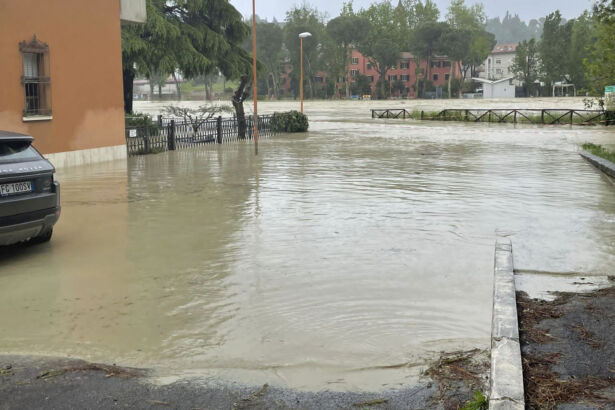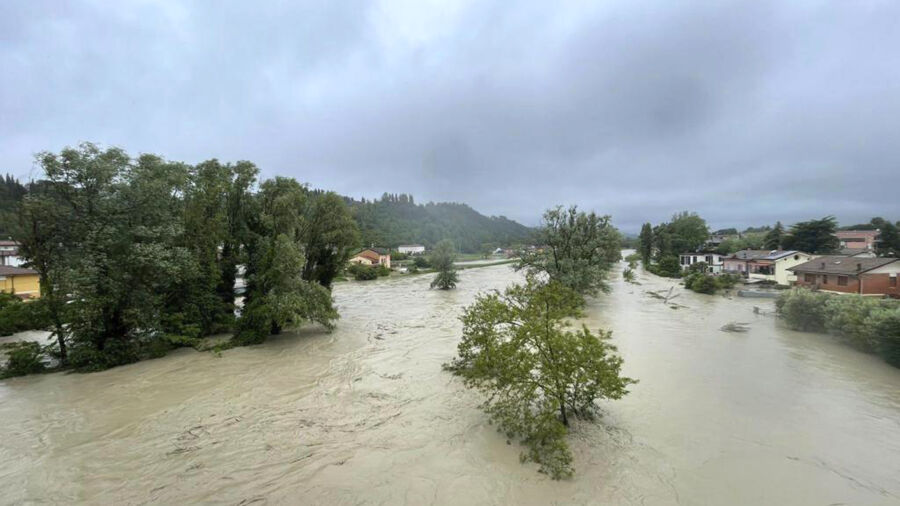CASTEL BOLOGNESE, Italy—Exceptional rains Wednesday in a drought-struck region of northern Italy swelled rivers over their banks, killing at least eight people and forcing the evacuation of thousands.
The heavy rains also forced Formula One to cancel this weekend’s Emilia-Romagna Grand Prix to not overtax emergency crews that were already stretched thin in responding to the rivers of mud that have torn through the region, wreaking havoc on infrastructure and homes.
Days of rainstorms stretched across a broad swath of northern Italy and the Balkans, where “apocalyptic” floods, landslides, and evacuations were also reported in Croatia, Bosnia, and Slovenia.
The deputy governor of Emilia-Romagna, Irene Priolo, said eight people were killed and others unaccounted for in flooding that forced the evacuation of more than 10,000 people.
On Wednesday evening, authorities in the province of Ravenna, a tourist town famed for its Byzantine-era mosaics, about 14,000 people were ordered to leave their homes as a precaution because of fears that three rivers could overflow their banks.
Among the dead was a farmer who defied floodwaters to try to save equipment on his property, officials said. His wife was among the missing.
Rescue helicopters plucked people from rooftops as floodwaters rose ever higher in homes. In one rescue, a coast guard member pulled a woman out through a skylight from her home and held her tight as the two were winched to a hovering helicopter and pulled inside.
“Even upper floors aren’t safe any more,” Gian Luca Zattini, mayor of Forli’, one of the hardest-hit towns, told Sky TG24 TV.

Italian Civil Protection Minister Nello Musumeci called for a new nationwide hydraulic engineering plan to adapt to the impact of increasing incidents of floods and landslides. At a briefing, he noted that an average of 200 millimeters (7.9 inches) of rain had fallen in 36 hours in the region, with some areas registering 500 millimeters (19.7 inches) in that period.
“If you consider that this region averages 1,000 millimeters (39.3 inches) of rain in a year, you realize the impact that these rains have had in these hours,” Musumeci said.
Citing the November landslide in Ischia, which killed a dozen people, he said that Italy is increasingly experiencing tropical weather seen in parts of Africa and other areas around the world, with long periods of drought punctuated by intense rainfall that can’t be absorbed by the soil.
“Nothing will ever be the same again … and what has happened in these hours is evidence of that,” Musumeci said. “When soil remains dry for a long time, instead of increasing its absorption capacity, it ends up cementing and allowing rainfall to continue flowing over the surface and causing absolutely unimaginable damage.”
In Castel Bolognese, a town of around 9,000 people, the mayor said there was no electricity and many families were running out of food in an area that was hit by floods earlier this month. “Two weeks ago we had a flood and we were left to believe it happens once every 100 years,” Luca Della Godenza said.
Hillsides, pounded by the rain, gave way in many parts of Emilia-Romagna. In 48 towns or hamlets, a total of 250 mudslides were reported by residents, state television said. Walls of mud, rushing down, toppled trees and buckled roads in their path.
Musumeci said 50,000 people lost electricity, and more than 100,000 lost cellphone or landline use.
Many residents evacuating homes put vital belongings in the rubber boats they’d normally tow each summer to the region’s flourishing beach resorts on the Adriatic Sea and pulled them through deluged streets.
Some regional train routes remained suspended Wednesday around Bologna and Ravenna, with severe delays elsewhere, the Italian state railway said.
Premier Giorgia Meloni, who was traveling to the G-7 meeting in Japan, said the government was monitoring the situation and was prepared to approve emergency aid.
In the Balkans, the swollen Una river flooded parts of northern Croatia and northwestern Bosnia, where authorities announced a state of emergency. The mayor of the town of Bosanska Krupa in Bosnia said that hundreds of homes had been flooded.
“We have an apocalypse,” Amin Halitovic told regional N1 network. “We can no longer count the flooded buildings. It’s never been like this.”
Dozens of landslides were reported in eastern Slovenia, many of which endangered homes and infrastructure.
In Croatia, hundreds of soldiers and rescue teams continued bringing food and other necessities to people in flood-hit areas who have been isolated in their homes. No casualties have been reported so far.

